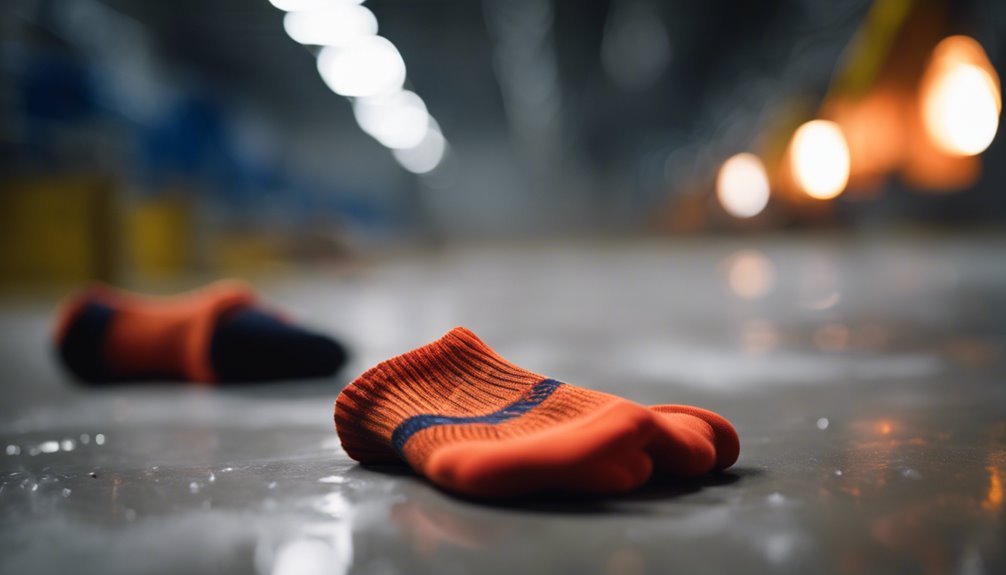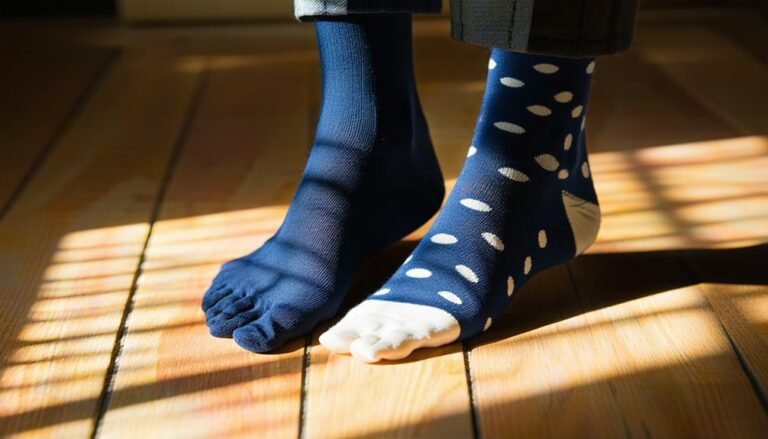The Best Socks for Factory Workers in High-Temperature Environments
In high-temperature factory environments, quality socks are essential for comfort and performance. Look for moisture-wicking materials, breathable fabrics, and thermal insulation to keep your feet dry and cool. Opt for socks with cushioning and arch support to reduce fatigue during long shifts. Brands that offer heavy-duty, cooling, and moisture-wicking options are ideal choices. Choosing the right socks can greatly enhance your work experience, and there's much more to discover about sock care and selection.
Understanding the Importance of Quality Socks in Hot Work Environments
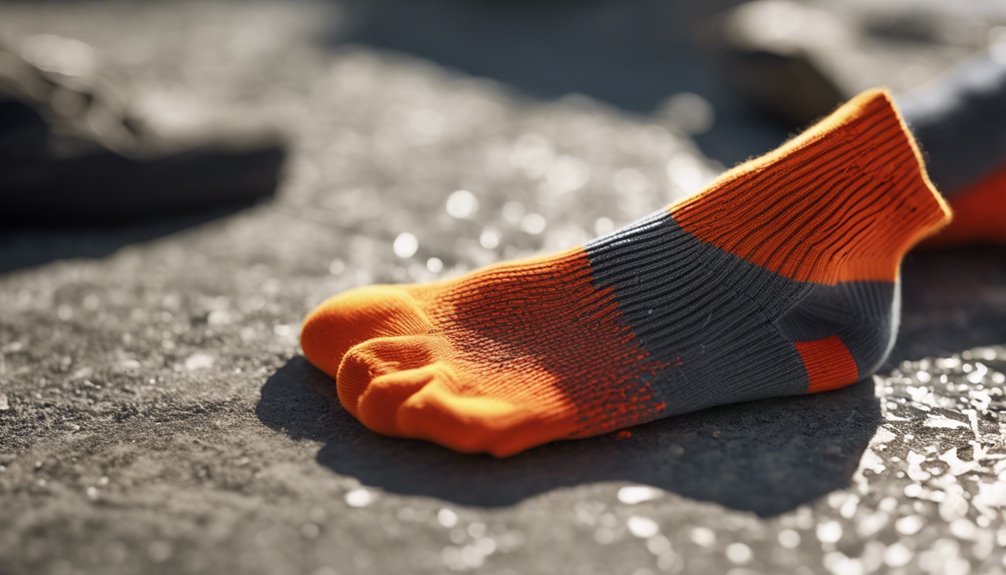
When you work in a hot environment, the importance of quality socks cannot be overstated. The right sock materials play a vital role in ensuring comfort and performance. Natural fibers like merino wool and moisture-wicking synthetics help regulate temperature, keeping your feet dry and cool. Heat resistance is essential; socks designed for high temperatures can prevent overheating and blisters, which are common in factory settings. Additionally, breathable fabrics allow for airflow, reducing the risk of fungal infections. Investing in quality socks tailored for hot conditions not only enhances your comfort but also boosts your efficiency and safety on the job. Your choice in socks can greatly impact your overall work experience, so prioritize quality for best performance.
Key Features to Look for in High-Temperature Socks
To guarantee peak performance in high-temperature environments, selecting the right socks involves considering several key features. First, look for thermal insulation properties that effectively regulate your foot temperature, keeping you comfortable throughout your shift. Materials such as merino wool or advanced synthetic blends can provide this benefit without sacrificing breathability. Additionally, prioritize odor control features; socks designed with antimicrobial treatments can greatly reduce unpleasant smells, allowing you to focus on your work without distraction. Moreover, make sure the socks offer a snug fit to prevent bunching, which can lead to blisters or discomfort. Finally, consider moisture-wicking technology to keep your feet dry, enhancing overall comfort and performance in demanding conditions. Choose wisely, and you'll feel the difference.
Top Moisture-Wicking Sock Brands for Factory Workers
Finding the right moisture-wicking socks is vital for factory workers who face long hours in demanding environments. When considering sock material comparisons, brands like Darn Tough and Smartwool stand out. They use merino wool blends, which provide excellent moisture management and comfort. Factory worker preferences often lean towards synthetic options like Thorlo and Wigwam, known for their durability and quick-drying properties. These brands incorporate advanced technology to enhance breathability and moisture control, significant for maintaining foot health during extended shifts. Don't overlook the importance of cushioning and arch support, which can make a substantial difference in overall comfort. By selecting the right brand, you can guarantee your feet stay dry and comfortable, allowing you to focus on your work without distraction.
The Benefits of Breathable Fabrics in Extreme Heat
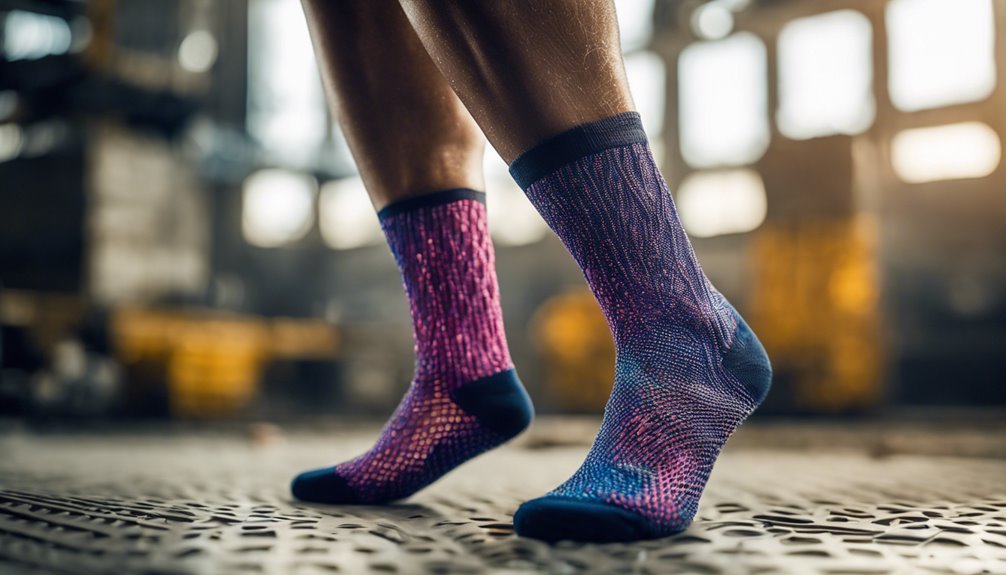
In extreme heat, breathable fabrics are essential for maintaining your comfort and performance. These materials feature moisture-wicking properties that draw sweat away from your skin, preventing discomfort and irritation. Additionally, enhanced airflow helps regulate your body temperature, allowing you to stay cool and focused on the job.
Moisture-Wicking Properties
When temperatures soar in factory environments, moisture-wicking fabrics become essential for maintaining comfort and performance. These breathable materials help regulate temperature by drawing sweat away from your skin, allowing for quicker evaporation. This process not only keeps your feet dry but also reduces the risk of blisters and fungal infections, vital in high-heat settings.
| Feature | Benefits | Importance |
|---|---|---|
| Moisture Control | Keeps feet dry | Reduces discomfort |
| Breathability | Enhances airflow | Aids in temperature regulation |
| Quick Drying | Minimizes sweat accumulation | Prevents odor and irritation |
| Durability | Long-lasting performance | Cost-effective in the long run |
Choosing the right socks with moisture-wicking properties can markedly improve your working conditions.
Enhanced Comfort Levels
While enduring extreme heat, the significance of breathable fabrics in socks cannot be overstated. The right sock materials, such as merino wool, bamboo, and specialized synthetics, promote effective temperature regulation. These fabrics allow air to circulate, preventing overheating and reducing sweat accumulation. As a result, your feet stay cooler and more comfortable throughout your shift.
Breathable socks also help minimize friction, which can lead to blisters and discomfort in high-temperature environments. By choosing socks designed with these advanced materials, you're not just enhancing comfort levels; you're also boosting your overall productivity. The right breathable sock can make a significant difference, allowing you to focus on your work without the distraction of discomfort. Ultimately, freedom in movement and comfort go hand in hand.
Cushioning and Support: Why It Matters for Long Shifts
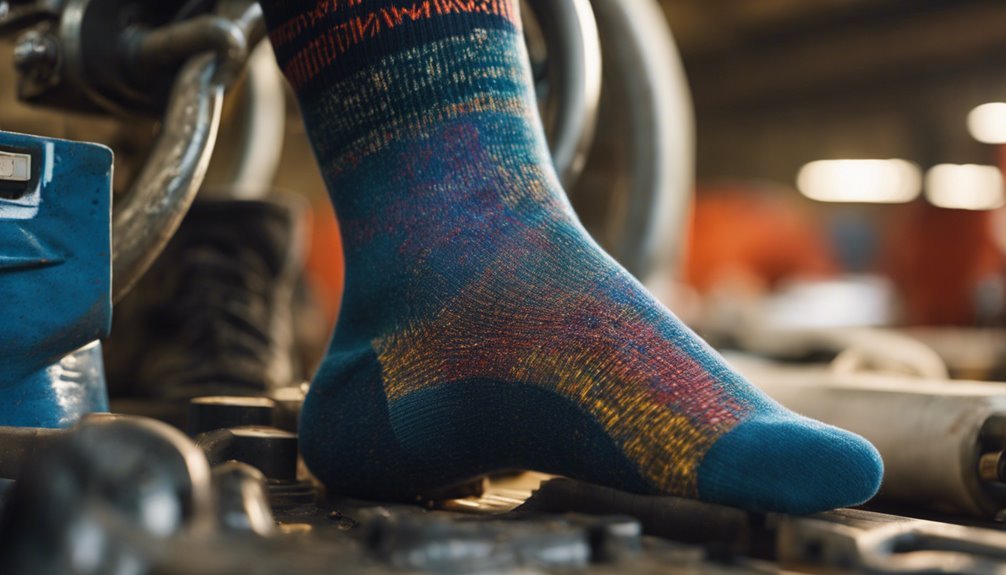
When you're on your feet for long shifts, proper cushioning and support in your socks can greatly enhance comfort levels. This added cushioning helps to absorb impact and reduces foot fatigue, allowing you to maintain productivity without discomfort. Investing in the right socks is essential for sustaining energy and performance throughout the day.
Enhanced Comfort Levels
Given the demanding nature of factory work, enhanced comfort levels through proper cushioning and support are vital for maintaining productivity during long shifts. High-quality socks provide padding that absorbs impact, reducing strain on your feet. This is where sock durability and advanced fabric technology play critical roles.
| Feature | Benefits | Importance |
|---|---|---|
| Cushioning | Reduces impact on feet | Prevents discomfort |
| Arch Support | Stabilizes foot position | Enhances balance |
| Moisture Control | Keeps feet dry | Reduces blisters and odors |
Investing in socks with these features guarantees your feet stay comfortable and supported, allowing you to focus on your tasks without unnecessary distractions.
Reducing Foot Fatigue
Proper cushioning and support in socks are essential for reducing foot fatigue during long factory shifts. The right sock materials, such as moisture-wicking blends and added padding, play an important role in maintaining foot health. These materials help to absorb shock and distribute pressure evenly across your feet, preventing discomfort and soreness. Look for socks with arch support and reinforced heel and toe areas, as these features enhance stability and prevent common injuries. Investing in high-quality socks can greatly improve your overall comfort, allowing you to stay focused and productive. By making these choices, you're not just protecting your feet; you're also promoting better circulation and reducing the risk of chronic foot issues that can arise from prolonged standing or walking.
Recommended Socks for Different Types of Factory Work
Choosing the right socks for different types of factory work can enhance comfort and performance, especially during long shifts. Here are some recommended options based on your specific environment:
- Heavy-Duty Work Socks: Look for high sock durability with reinforced heels and toes, perfect for tough tasks.
- Cooling Socks: Opt for materials designed for thermal regulation, keeping your feet cool during high-temperature work.
- Moisture-Wicking Socks: These help manage sweat, preventing discomfort and blisters during extended wear.
- Compression Socks: Ideal for those who stand for long periods, providing support to reduce fatigue and promote circulation.
Selecting the right socks not only boosts comfort but also enhances your overall productivity on the factory floor.
Care and Maintenance Tips for Your Work Socks
Although you might think that socks are low-maintenance, taking proper care of your work socks is essential for maximizing their lifespan and performance. Start with sock washing; always follow the manufacturer's instructions, and opt for cold water to prevent shrinkage and fabric degradation. Avoid fabric softeners, as they can diminish moisture-wicking properties.
After washing, make sure your socks are thoroughly dried to prevent mildew and odors. Ideally, air-dry them to maintain elasticity.
When it comes to sock storage, keep them in a cool, dry place, away from direct sunlight. Rolling or folding them neatly helps maintain their shape and prevents damage. By following these care and maintenance tips, you'll make certain your work socks stay in prime condition, ready for any task.
How to Choose the Right Size and Fit for Optimal Comfort
Taking care of your work socks is only one part of guaranteeing all-day comfort; selecting the right size and fit is equally important. Here's how to guarantee ideal sock sizing and fit importance:
- Measure Your Feet: Always measure both feet, as they may differ in size.
- Check Size Charts: Refer to the manufacturer's size chart for accurate measurements.
- Consider Sock Material: Different materials can affect fit; choose those that provide stretch and recovery.
- Test the Fit: Guarantee the socks fit snugly without being tight, eliminating bunching or slipping.
Personal Experiences: Workers Share Their Best Sock Choices
When it comes to finding the best socks for factory work, personal experiences can offer invaluable insights. Many workers emphasize the importance of sock durability; they often recommend materials like merino wool and high-performance synthetic blends. These fabrics not only withstand rigorous wear but also manage moisture effectively, enhancing foot hygiene throughout long shifts.
One factory worker shared that socks with reinforced heels and toes last considerably longer, reducing the need for frequent replacements. Another noted the benefits of moisture-wicking socks, which help prevent blisters and keep feet dry. Ultimately, choosing the right socks can enhance comfort and productivity, allowing you to focus on your work without the distraction of foot discomfort. Prioritize durability and hygiene for ideal performance in high-temperature environments.
Frequently Asked Questions
Can I Wear Regular Socks in High-Temperature Factory Environments?
You can wear regular socks, but they may lack effective temperature regulation. Opt for specialized sock materials like merino wool or moisture-wicking synthetics to guarantee comfort and breathability in high-temperature environments.
How Often Should I Replace My Work Socks?
You should replace your work socks every six months, or sooner if they show signs of wear. Maintaining sock durability and effective moisture management is essential to prevent discomfort and guarantee peak performance during long shifts.
Are There Specific Colors That Are Better for Hot Environments?
In hot environments, lighter colors enhance temperature regulation due to color psychology, reflecting heat rather than absorbing it. Choosing socks in whites or pastels can help you stay cooler and more comfortable throughout your workday.
Do Compression Socks Help in High-Temperature Work Settings?
Compression socks can aid in high-temperature work settings by providing compression benefits, which enhance circulation. This, in turn, supports temperature regulation, helping you stay comfortable and focused without sacrificing freedom of movement during demanding tasks.
Can Socks Really Prevent Blisters in Extreme Heat?
Wondering if socks can really prevent blisters in extreme heat? The right materials—like moisture-wicking fibers—play an essential role in blister prevention, keeping your feet dry and comfortable while you work hard in sweltering conditions.

